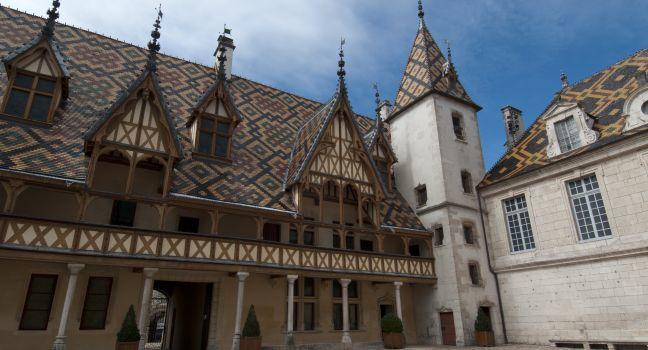Fodor's Expert Review Hospices de Beaune

With its steep, gabled roof colorfully tiled in intricate patterns, the famed Hospices de Beaune is this city’s top attraction—and one of Burgundy’s most iconic sights. Better known to some as the Hôtel-Dieu, it was founded in 1443 as a hospital to provide free care for the poor after the Hundred Years' War. The interior looks medieval but was repainted by 19th-century restorer Ouradou (Viollet-le-Duc's son-in-law); it centers on the grand salle, more than 160 feet long, with the original furniture, a great wooden roof, and the super-picturesque cour d'honneur. The Hospices carried on its medical activities until 1971—its nurses still wearing their habitlike uniforms—and the hospital's history is retraced in the museum, whose wide-ranging collections contain some odd medical instruments from the 15th century. You can also see a collection of tapestries that belonged to the repentant founder of the Hospices, ducal chancellor Nicolas Rolin, who hoped charity would relieve him... READ MORE
With its steep, gabled roof colorfully tiled in intricate patterns, the famed Hospices de Beaune is this city’s top attraction—and one of Burgundy’s most iconic sights. Better known to some as the Hôtel-Dieu, it was founded in 1443 as a hospital to provide free care for the poor after the Hundred Years' War. The interior looks medieval but was repainted by 19th-century restorer Ouradou (Viollet-le-Duc's son-in-law); it centers on the grand salle, more than 160 feet long, with the original furniture, a great wooden roof, and the super-picturesque cour d'honneur. The Hospices carried on its medical activities until 1971—its nurses still wearing their habitlike uniforms—and the hospital's history is retraced in the museum, whose wide-ranging collections contain some odd medical instruments from the 15th century. You can also see a collection of tapestries that belonged to the repentant founder of the Hospices, ducal chancellor Nicolas Rolin, who hoped charity would relieve him of his sins—one of which was collecting wives. Outstanding are both the tapestry he had made for Madame Rolin III, with its repeated motif of "my only star," and one relating the legend of St-Eloi and his miraculous restoration of a horse's leg.
But the showstopper at the Hôtel-Dieu is Rogier Van der Weyden's stirring, gigantic 15th-century masterpiece The Last Judgment, commissioned for the hospital's chapel by Rolin. The intense colors and mind-tripping imagery were meant to scare the illiterate patients into religious submission. Notice the touch of misogyny; more women are going to hell than to heaven, while Christ, the judge, remains completely unmoved. The Hospices own around 150 acres of the region's finest vineyards, much of it classified as Grand or Premier Cru.
READ LESS



